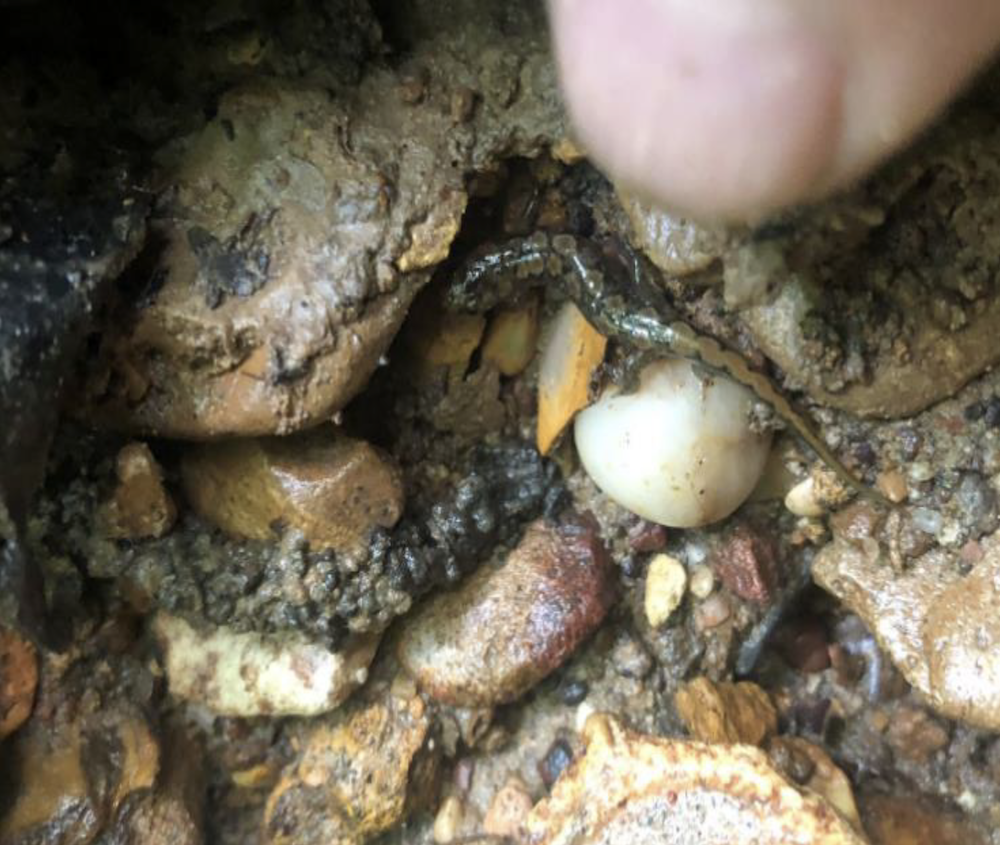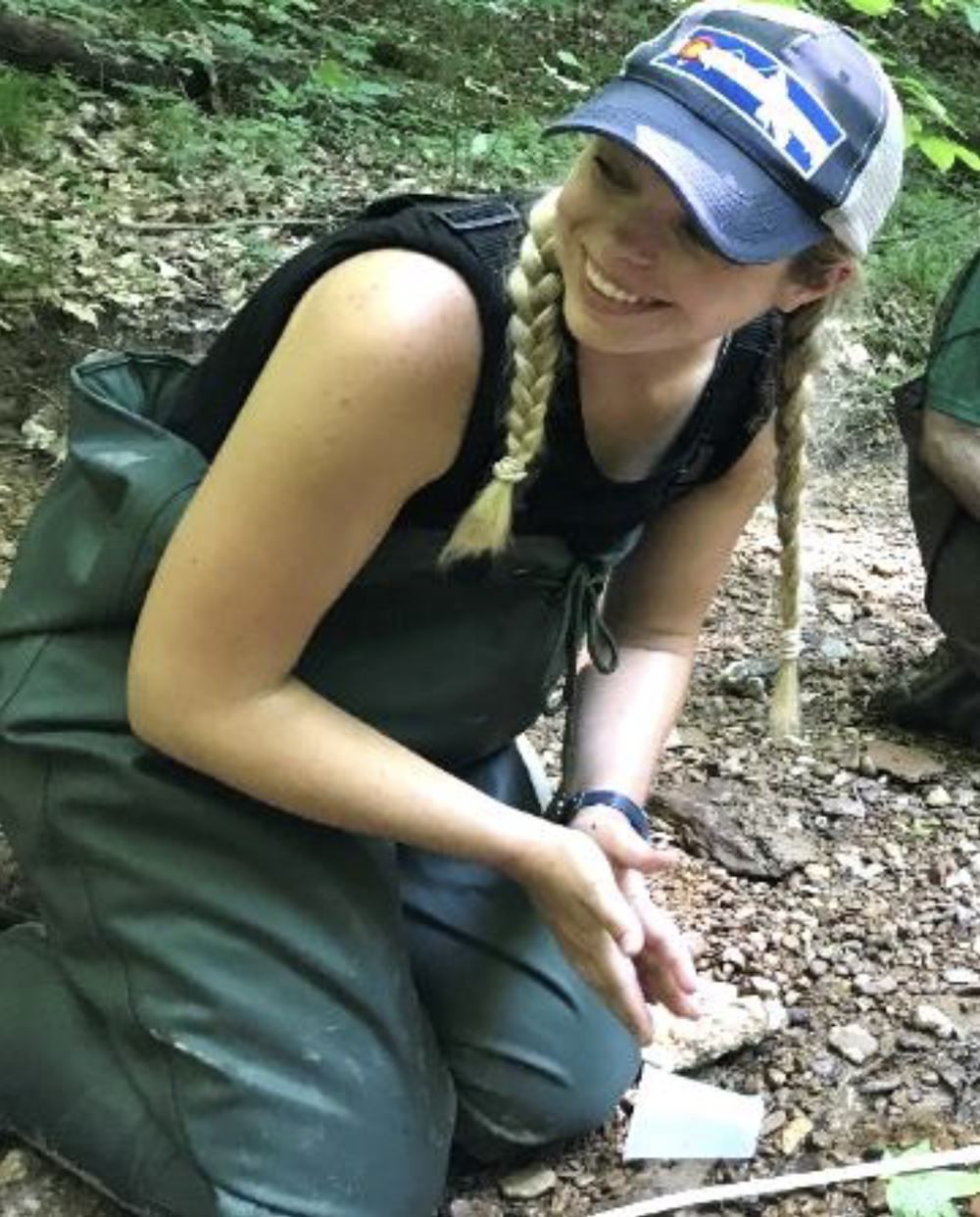
IDNR biologists focus on finding the elusive salamander. All photos courtesy of the author.



IDNR biologists focus on finding the elusive salamander. All photos courtesy of the author.
Natural resource managers make difficult decisions regarding Illinois’ wildlife populations every day, and some weigh heavy on our collective conscience. Such is the case when Illinois Department of Natural Resources’ (IDNR) consultation staff in the Office of Realty and Environmental Planning review projects that could destroy Illinois-endangered and -threatened species habitats. One recent incident involved a project near one of the few known locations of the state-endangered spotted dusky salamander (Desmognathus conanti), a listed species since 1977.

Adult spotted dusky salamanders can be identified by the six to eight pairs of spots on their backs that fuse together to form a broad, irregular stripe that continues onto the tail. Adults may reach 5 inches in length.
This salamander transforms from an egg and continues to develop through its larval stages within the leaf litter and rocks of cool, spring-fed headwater streams found in forested habitats. A member of the lungless salamander family (Plethodontidae), spotted dusky salamanders respire through their skin and mouth tissue, making the cool, clear water vital to their survival.

The spotted dusky salamander is endemic to North America and is considered secure due to the species’ stable status in the southern portion of its range. Their range within the U.S. includes south-central and southern states, extending as far west as Texas and as far east as the Carolinas. In portions of its range this salamander is so abundant that it can be legally offered as fishing bait. Illinois, however, is at the northern extent of its range, and the spotted dusky salamander is found naturally only in Pulaski County. A small, introduced population is known from Johnson County, but it cannot be considered when evaluating native range.

Suitable habitat for this salamander is comprised of a unique and specific combination of features. The species has been found only within and along cool streams flowing year-round where a geologic layer known as Porter’s Creek Clay appears near the surface. The clay is intermingled with Cretaceous gravel deposits formed more than 60 million years ago under warm, shallow, marine conditions.
Porter’s Creek Clay is highly valued by the kitty litter and oil change industries for its absorbent qualities. The extraction of this clay is the primary threat to Illinois’ population of spotted dusky salamanders. Mining can cause direct mortality to individual salamanders when streams are removed, and may indirectly disrupt the micro-hydrology of the habitat. Sedimentation also poses a risk to survival by degrading habitat. As occurs in many species having isolated populations, the spotted dusky salamander is susceptible to local extirpations due to diminished genetic diversity.

In 1979, herpetologists Dr. James E. Huheey and Dr. Ronald A. Brandon concluded a multi-year systematic survey to investigate the range of the spotted dusky salamander in Illinois. Identifying wooded headwater ravines on topographic and aerial maps, they conducted surveys and found populations in drainages to rivers and their tributaries in Pulaski County. In 2006, 23 known species locations were resurveyed. Spotted dusky salamanders of every life stage (larva, juvenile, subadult or adult) were observed in all but three locations.
More current comprehensive and standardized surveys were necessary to inform the regulatory process and to discern the status of this amphibian in the wild in Illinois. In May and June of 2019, an extensive standardized survey was conducted at both historic and computer-modeled locations to update the distribution of the spotted dusky salamander in Illinois. Surveys documented the salamander remained at most locations where they had previously been observed. New populations were found within computer-modeled habitat, demonstrating the conservation value of using predictive habitat distribution modeling to guide field survey efforts. Most promising to surveyors was the continued evidence of recruitment (new individuals being added to the population) of the spotted dusky salamander, indicating successful reproduction and survival.

An enhanced understanding of this vulnerable salamander’s status helps natural resource managers bring conservation benefit to the species. Continually seeking out essential habitat land protection through conservation easements and improving habitat conditions will assist known populations. Proactive strategies are necessary to avoid or minimize future impacts within the watershed.
Such conservation measures are performed with the goal of stabilizing the species’ status within Illinois.
Baylee McLaughlin is an Environmental Scientist for HDR Engineering, Inc., where she performs environmental quality surveys and assists with fish hatchery bioprogram modeling. She graduated from the University of Illinois Springfield in 2020, where she completed her M.S. in Environmental Science while interning for the Illinois Department of Natural Resources’ Division of Natural Heritage.
Submit a question for the author